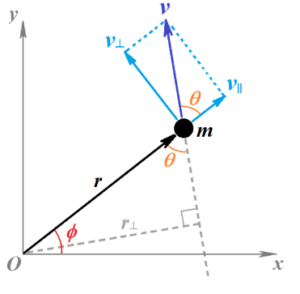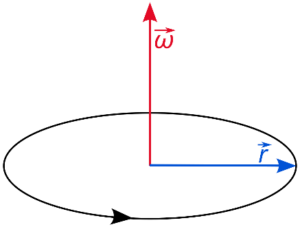Angular or rotational motion is an important part of kinematics in physics. The application of angular motion can be seen in several day-to-day activities.
Some angular motion examples are:
- Figure skating, Acrobatics, Gymnastics
- Freestyle swimming
- Swinging of a cricket or baseball bat
- Swinging of a badminton or tennis racket
- Running or racing on a circular track
- Leveraging on a hockey stick
- Swinging
- Paddling a bicycle
- Rowing a boat
- Churning milk
Let us learn about the angular motion examples in detail.
1. Figure skating, Acrobatics, Gymnastics:
In the sport of figure skating or gymnastics player or the performer is required to maintain an angular velocity while traveling in different patterns of circular or curved paths. These players move across an angle along an axis. Angular motion can be easily identified in this kind of activity.

2. Freestyle swimming
Swimming involves the movement of the player in an angular motion around a very long axis. The swimmer is required to maintain a steady angular velocity during freestyle swimming so that they do not lose balance in the water. Angular motion can be easily identified in swimming also.
3. Swinging of a cricket or baseball bat:
In sports like cricket or baseball, the player is required to swing their bat to hit the ball. The motion of the swing is a type of angular motion. The batsman swings the bad with the steady angular velocity around an axis. The way that the bat is swung determines the direction in which the ball will travel and the location where the ball will land.
4. Swinging of a badminton or tennis racket:
In sports like badminton and tennis reply is required to hit the ball or the shuttlecock with the racket. This involves a swinging action that is a type of angular motion. The racquet is swung with a certain velocity around an axis of rotation. This Singh action determines the direction in which the ball or the shuttlecock will travel and the location where it will land.
5. Running or racing on a circular track:
Running a racing on a circular track in a car, bike, cycle, or by feet involves the action of angular motion. The person or the vehicle travels at a certain velocity around an axis. It is considered to be essential to retain a suitable angular momentum to elude the happening of any form of accident.
6. Leveraging on a hockey stick:
In the sports of hockey, one has to hit the hockey puck with a hockey stick. Leveraging the black with the hockey stick involves angular motion. The mistake revolves round an axis with a certain velocity. The angular motion of the hockey sticks in this case determines the direction and the distance that the puck will go.
7. Swinging:
Swings in playgrounds are operated totally on angular motion principles. This swing moves around a fixed axis of rotation. For the swinging action to occur, the person has to provide force externally.
8. Paddling a bicycle:
The paddling of a bicycle involves the rotation of the paddle around a fixed axis at a certain velocity. For the paddling action to take place the person needs to provide external force.
9. Rowing a boat:
To row a boat, one needs to swing the ore with a certain velocity along an axis of rotation. For the rowing action to take place force needs to be provided externally.
10. Churning milk:
To turn milk one uses a stick-shaped object to stir the milk. Stirring the stick involves the use of angular motion. This motion enables the stick to rotate around an axis at a certain velocity.
Therefore, we can find the application of angular motion in several sports activities. In fact, angular motion plays a major role in determining how the sport is played. To understand more about angular motion, give the following paragraphs a read.
FAQs
What is angular motion?
Angular motion is a common occurrence that we can see in our daily lives.
In physics, angular motion is said to represent the motion of an object rotating around a fixed axis or point at a certain velocity. Mathematically, angular motion is given by the angle subtended by the body in its course of motion along an axis or a fixed point. Suppose we fix a pin in the center of a table and attach a thread with the pin. On the other end of the thread if we attach an object and move it in a motion such that the thread remains straight throughout, then the angle covered during its motion is termed angular motion.
What is angular momentum?
Angular momentum (also known as moment of momentum or rotational momentum) refers to the rotational or angular equivalent of linear momentum.
Mathematically, angular momentum in three dimensions is given by the cross product of the position of the object i.e. position vector with the momentum vector of the object (Linear momentum vector of an object is given by the product of mass and velocity i.e. p = mv). This can be represented as r × p, and this makes angular momentum a pseudo-vector quantity.
Linear momentum does not depend on the origin reference point whereas the angular momentum depends largely on the reference point for the origin as the position vector of the object is measured from the reference point. The net angular momentum of a closed system is said to remain constant. For this reason, angular momentum is considered to be a conserved physical quantity.

Read more about the Simple Pendulum’s Potential to Kinetic energy conversation.
What is angular velocity?
Angular velocity in physics can be further classified into two major subcategories: orbital angular velocity and other is spin angular velocity.
Orbital Angular velocity: Orbital angular velocity gives us information about how much time a rigid object takes to revolve around a fixed reference point or origin. Orbital angular momentum basically provides the rate of change of the angular position of a rigid body with respect to the given origin.

Spin angular velocity: Spin angular velocity gives us information about how much time a rigid object takes to rotate with respect to its central axis of rotation. Spin angular velocity does not depend on the reference point or the origin. This factor makes it different from the orbital angular velocity.
The dimension of angular velocity is given by angle per unit time which in SI unit becomes radian per unit second.
Does angular velocity change in circular motion?
Angular velocity of a rigid body moving in a circular motion remains constant i.e. it does not change with time.
When an object moves in a circular motion it covers an equal amount of angles in an equal amount of time around a fixed point. The position vector of the object from the origin remains constant in magnitude throughout i.e. R (radius of the circle). Hence we can say that the angular velocity remains constant for an object that travels in a circular motion.
What is the angular velocity of Earth?
Earth revolves around the sun in an angular motion. It also rotates around a fixed axis with a certain velocity.
The angular velocity of the Earth rotating around a fixed axis is given by w and is equivalent to 15.04108°/mean solar hour based on a sidereal day. This is equal to 360°/23 hours 56 minutes 4 seconds i.e. approximately one day. The angular velocity of the Earth can be denoted in terms of radian/second by the formula w(earth) = 2π/T, where T is the time taken to complete one rotation i.e. 23 hours 56 minutes 4 seconds.

We hope this post could provide the necessary information related to angular motion examples.

Hi, I am Sanchari Chakraborty. I have done Master’s in Electronics.
I always like to explore new inventions in the field of Electronics.
I am an eager learner, currently invested in the field of Applied Optics and Photonics. I am also an active member of SPIE (International society for optics and photonics) and OSI(Optical Society of India). My articles are aimed at bringing quality science research topics to light in a simple yet informative way. Science has been evolving since time immemorial. So, I try my bit to tap into the evolution and present it to the readers.
Let’s connect through